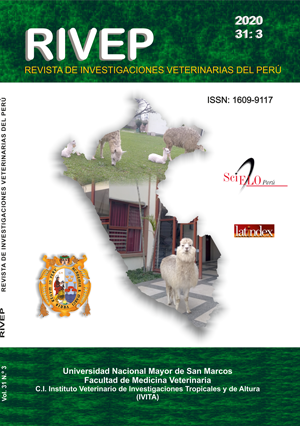Evaluation of an oestrus synchronization protocol in sheep with temporary weaning for artificial insemination at fixed time
DOI:
https://doi.org/10.15381/rivep.v31i3.16820Keywords:
sheep, weaning, equine chorionic gonadotropin, artificial inseminationAbstract
The research aimed to evaluate a protocol of induction of oestrous in lactating ewes with hormonal treatment of progestins and eCG with temporary weaning of lambs for artificial insemination at a fixed time by transcervical route using refrigerated semen on the presentation of oestrous and pregnancy and lambing rate. In total, 37 ewes were distributed among three treatments: T1, lactating ewes with temporary weaning (n=15); T2, lactating ewes with lamb at foot (n=10); T3, dry ewes without lamb (n=12). Temporary weaning was for 48 h prior to insemination. T1 and T3 presented a higher rate of manifest oestrous (100 and 91.66%, respectively) than T2 (60%; p<0.05). The non-return heat rate at 14-17 days post-service was statistically similar between groups (93.33, 60.0, 91.66% for T1, T2 and T3, respectively). Similarly, the pregnancy percentage by ultrasound at 45 days and the percentage of lambing showed similar values and were statistically similar (93.33, 60.0 and 66.67 and for T1, T2 and T3, respectively).
Downloads
Downloads
Published
Issue
Section
License
Copyright (c) 2020 Saúl Espinoza Molina, Yulyssa del Pilar Gamarra Reyes, Chessyra Ninoska Ticona Huaroco, Mario CCari Huayta, Gabriela Espinoza Rojas, Uri Harold Harold Perez Guerra, Danny Julio Cruz Flores

This work is licensed under a Creative Commons Attribution-NonCommercial-ShareAlike 4.0 International License.
AUTHORS RETAIN THEIR RIGHTS:
a. Authors retain their trade mark rights and patent, and also on any process or procedure described in the article.
b. Authors retain their right to share, copy, distribute, perform and publicly communicate their article (eg, to place their article in an institutional repository or publish it in a book), with an acknowledgment of its initial publication in the Revista de Investigaciones Veterinarias del Perú (RIVEP).
c. Authors retain theirs right to make a subsequent publication of their work, to use the article or any part thereof (eg a compilation of his papers, lecture notes, thesis, or a book), always indicating the source of publication (the originator of the work, journal, volume, number and date).



